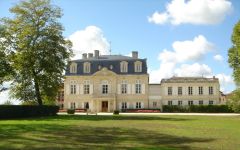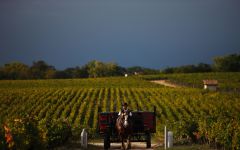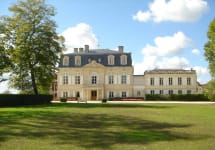Chateau Pontet-Canet (Futures Pre-Sale) 2024
-
Robert
Parker - Vinous
-
James
Suckling



Product Details
Your Rating
Somm Note
Winemaker Notes
The summer was marked by a beneficial drought, which is always a great asset for wine quality. Veraison began under dry conditions, with temperatures in line with the decade’s averages. In this seasonal dryness, water stress gradually set in, leading to the destruction of herbaceous aromas and the synthesis of fruity aromas.
At the end of August, an unstable sky reappeared and persisted until the end of the harvest. They made a happy choice in risk-taking to harvest ripe grapes that paid off. Patience guided their every move, giving priority to observing and listening to the vineyard. They took the time to wait for optimal ripeness, giving this vintage every chance to become a beautiful "Grand Vin".
Blend: 52% Cabrenet Sauvignon, 43% Merlot, 4% Petit Verdot, 1% Cabernet Franc
This wine does not include the blanket 10% tariff imposed in April 2025. When the wines are shippable in fall of 2027, customers will have the option to pay any tariff in place at the time or to keep their wines stored in a temperature-controlled facility free of charge in France.
Professional Ratings
-
Robert Parker's Wine Advocate
The 2024 Pontet-Canet underlines the fact that daring to harvest late paid dividends in this challenging vintage, wafting from the glass with aromas of cassis, black raspberries and plums mingled with accents of rose petals, licorice and exotic spices. Medium to full-bodied, deep and integrated, with mid-palate density that's all too rare this year, it's layered, suave and seamless, concluding with a long, sapid finish. Picking began on September 26 and concluded on October 11, with the heart of the estate's old-vine Cabernet Sauvignon coming in between the seventh and the ninth, well after many châteaux had finished their harvest. Greater reactivity during the season means that Pontet-Canet's vineyards are gaining in vigor, while in the winery, a lighter touch with extraction, systematic climate control and a wholesale refinement of the estate's cooperage choices have brought new harmony and sensuality to this estate's wines. That has combined with a willingness to take risks with harvest dates to deliver what is clearly one of the wines of the vintage. The blend is roughly half Cabernet Sauvignon and Merlot, with the balance Petit Verdot and Cabernet Franc.
Barrel Sample: 94-96 -
Vinous
The 2024 Pontet-Canet is one of the most elegant wines I have tasted here in some time, as in a long time. Brisk acids and beams of tannin shape a mid-weight, classically built Pontet-Canet unlike any I have tasted. The 2024 is not an obvious wine, it does not have the opulence of most recent years, rather it is a wine that impresses with its energy, tension and class. Floral, spice and mineral notes stain the palate in this vibrant, beautifully sculpted Pontet-Canet. The 2024 is seriously impressive, but it is also less immediate than what was once the norm because of a shift towards a style that favors greater energy and vibrancy than in the recent past. The evolution here is going to be fascinating to follow in the coming years. Tasted three times. –Antonio Galloni
Barrel Sample: 94-96 -
James Suckling
A light but juicy wine that's fresh and fluid, with good depth of blue fruit and violets, a medium body and nicely reactive tannins. Crunchy, with a delicate mid-palate and firm, chalky tannins. Long, balanced and pristine finish. This will show early appeal. 52% cabernet sauvignon, 43% merlot, 4% petit verdot and 1% cabernet franc.
Barrel Sample: 95-96
Other Vintages
2023-
Robert
Parker -
James
Suckling -
Jeb
Dunnuck - Decanter
- Vinous
-
Jeb
Dunnuck -
James
Suckling - Decanter
-
Wine
Spectator
-
Wine
Enthusiast -
James
Suckling - Decanter
-
Jeb
Dunnuck -
Robert
Parker -
Wine
Spectator
-
James
Suckling -
Wine
Enthusiast -
Robert
Parker -
Jeb
Dunnuck - Decanter
- Vinous
-
Robert
Parker -
James
Suckling -
Wine
Enthusiast - Decanter
-
Wine
Spectator -
Jeb
Dunnuck
-
Robert
Parker -
Wine
Enthusiast -
James
Suckling -
Jeb
Dunnuck - Decanter
-
Robert
Parker -
Wine
Enthusiast -
James
Suckling -
Wine
Spectator - Decanter
-
Jeb
Dunnuck
-
Wine
Enthusiast - Decanter
-
Jeb
Dunnuck -
Robert
Parker -
James
Suckling -
Wine
Spectator
-
James
Suckling -
Wine
Enthusiast -
Robert
Parker - Decanter
-
Jeb
Dunnuck -
Wine &
Spirits -
Wine
Spectator
-
James
Suckling -
Jeb
Dunnuck -
Wine
Enthusiast - Decanter
-
Robert
Parker -
Wine
Spectator
-
Wine
Enthusiast -
James
Suckling -
Wine
Spectator -
Robert
Parker
-
Wine
Enthusiast -
Robert
Parker -
James
Suckling -
Wine
Spectator -
Jeb
Dunnuck
-
Wine
Enthusiast -
James
Suckling -
Robert
Parker - Decanter
-
Wine
Spectator
-
Robert
Parker -
James
Suckling -
Wine
Enthusiast -
Jeb
Dunnuck -
Wine
Spectator
-
Robert
Parker -
Wine
Enthusiast -
Jeb
Dunnuck -
James
Suckling -
Wine
Spectator - Decanter
-
Robert
Parker -
Jeb
Dunnuck -
Wine
Enthusiast -
James
Suckling -
Wine
Spectator
-
Wine
Enthusiast -
Robert
Parker -
Wine
Spectator
-
James
Suckling -
Robert
Parker -
Wilfred
Wong -
Wine
Spectator -
Wine
Enthusiast
-
Jeb
Dunnuck -
Robert
Parker -
Wine
Spectator -
Connoisseurs'
Guide -
Wine
Enthusiast -
Wine &
Spirits
-
Wine
Enthusiast -
Wine
Spectator -
Jeb
Dunnuck -
Robert
Parker
-
Robert
Parker -
Wine
Spectator -
James
Suckling -
Wine
Enthusiast
-
Wine
Spectator
-
Wine
Spectator
-
James
Suckling -
Wine
Spectator -
Robert
Parker -
Wine
Enthusiast
-
Robert
Parker -
Wine
Spectator
-
Wine
Spectator -
Robert
Parker
-
Robert
Parker
-
Wine
Spectator





Jean Francois Pontet, Royal Master of the Horse in the early 18th Century, bought and consolidated several plots of land located northwest of Pauillac. Several years later, in 1750, his descendants bought neighboring vineyards in an area named "Canet", thus creating one of the largest estates in the entire Medoc. Chateau Pontet-Canet's topography and soil predestined it to produce great wine.
In 1865, the noted wine shipper Hermann Cruse acquired the chateau and its 120 hectares of vones. The Cruse dynasty provided the financial means to make one of the greatest wines in the Medoc. In 1975, Guy Tesseron, solidly implanted in the Cognac region, and owner of Lafon Rochet in St-Estephe, purchsed Pontet-Canet.
The family's avowed ambition is to pass on the history of Chateau Pontet-Canet and secure its future. Today, it is Guy Tesseron’s descendants who own the estate today: Alfred and his nieces Mélanie and Philippine, daughters of his late brother Gérard. Together, they have the same outlook. Alfred shares his vision of the estate with Mélanie, passing on to her its traditions, his outlook on vinegrowing and his passion for wine.
In 2004, the year of the first biodynamic trial which took place on 14 hectares, the wines were radiant, tighter and brighter. Alfred urged Jean-Michel to go further. The estate was fully converted to biodynamic agriculture. This decision became a commitment and a challenge, but also a first for a Médoc Classified Growth.
Since then, with each vintage comes new knowledge, furthering the understanding of the terroir in a profound way. The vine’s resistance to disease is better known today, the understanding of how different parcels behave has improved, always in keeping with biodynamic principles. It requires sincerity, pragmatism and transparency: in a nutshell, absolute dedication.
The wines of Chateau Pontet-Canet obtained organic certification from Ecocert and biodynamic certification from Biodyvin in 2010 and from Demeter in 2014.
A shared state of mind and a particular sensitivity are the key factors which have propelled Chateau Pontet-Canet to the summit of Bordeaux wines in recent years. They are the expression of the Tesseron family’s quiet determination to ensure continuity over the long term.

One of the world’s most classic and popular styles of red wine, Bordeaux-inspired blends have spread from their homeland in France to nearly every corner of the New World. Typically based on either Cabernet Sauvignon or Merlot and supported by Cabernet Franc, Malbec and Petit Verdot, the best of these are densely hued, fragrant, full of fruit and boast a structure that begs for cellar time. Somm Secret—Blends from Bordeaux are generally earthier compared to those from the New World, which tend to be fruit-dominant.

The leader on the Left Bank in number of first growth classified producers within its boundaries, Pauillac has more than any of the other appellations, at three of the five. Chateau Lafite Rothschild and Mouton Rothschild border St. Estephe on its northern end and Chateau Latour is at Pauillac’s southern end, bordering St. Julien.
While the first growths are certainly some of the better producers of the Left Bank, today they often compete with some of the “lower ranked” producers (second, third, fourth, fifth growth) in quality and value. The Left Bank of Bordeaux subscribes to an arguably outdated method of classification that goes back to 1855. The finest chateaux in that year were judged on the basis of reputation and trading price; changes in rank since then have been miniscule at best. Today producers such as Chateau Pontet-Canet, Chateau Grand Puy-Lacoste, Chateau Lynch-Bages, among others (all fifth growth) offer some of the most outstanding wines in all of Bordeaux.
Defining characteristics of fine wines from Pauillac (i.e. Cabernet-based Bordeaux Blends) include inky and juicy blackcurrant, cedar or cigar box and plush or chalky tannins.
Layers of gravel in the Pauillac region are key to its wines’ character and quality. The layers offer excellent drainage in the relatively flat topography of the region allowing water to run off into “jalles” or streams, which subsequently flow off into the Gironde.
